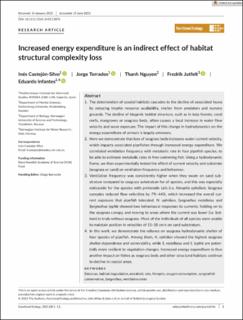| dc.description.abstract | The deterioration of coastal habitats cascades to the decline of associated fauna by reducing trophic resource availability, shelter from predators and nursery grounds. The decline of biogenic habitat structure, such as in kelp forests, coral reefs, mangroves or seagrass beds, often causes a local increase in water flow velocity and wave exposure. The impact of this change in hydrodynamics on the energy expenditure of animals is largely unknown. Here we demonstrate that loss of seagrass beds increases water current velocity, which impacts associated pipefishes through increased energy expenditure. We correlated ventilation frequency with metabolic rate in four pipefish species, to be able to estimate metabolic rates in free-swimming fish. Using a hydrodynamic flume, we then experimentally tested the effect of current velocity and substrate (seagrass or sand) on ventilation frequency and behaviour. Ventilation frequency was consistently higher when they swam on sand substratum compared to seagrass substratum for all species, and this was especially noticeable for the species with prehensile tails (i.e. Nerophis ophidion). Seagrass canopies reduced flow velocities by 7%–44%, which increased the overall current exposure that pipefish tolerated. N. ophidion, Syngnathus rostellatus and Syngnathus typhle showed two behavioural responses to currents: holding on to the seagrass canopy, and moving to areas where the current was lower (i.e. bottom) in trials without seagrass. Most of the individuals of all species were unable to maintain position in velocities of 15–18 cm/s on sand substratum. In this work, we demonstrate the reliance on seagrass hydrodynamic shelter of four species of pipefish. Among them, N. ophidion showed the highest seagrass shelter dependence and vulnerability, while S. rostellatus and S. typhle are potentially more resilient to vegetation changes. Increased energy expenditure is thus another impact on fishes as seagrass beds and other structural habitats continue to decline in coastal areas. | |

